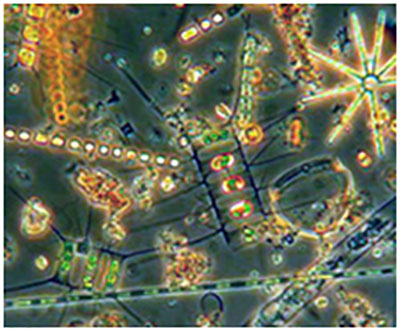Algae (Phytoplankton)

The Maryland phytoplankton monitoring program evaluates the algal community
at 34 Chesapeake and 13 Coastal Bays stations monthly (April – Nov).
Phytoplankton are a critical component of the Bay ecosystem and represent the first biological response to the Bay’s nutrient enrichment problem. It is the overgrowth of algae that has led to the Bay’s low oxygen problems.
Results are used to show the success of Bay cleanup efforts, explain important linkages between water quality and living resources, and provide an early warning of potentially harmful exotic species.
Harmful Algal Blooms
 Algae are a natural and critical part of our Chesapeake and Coastal Bays ecosystems. Algae, like land plants, capture the sun’s energy and support the food web that leads to fish and shellfish. They occur in a size range from tiny microscopic cells floating in the water column (phytoplankton) to large mats of visible “macroalgae” that grow on bottom sediments.
Algae are a natural and critical part of our Chesapeake and Coastal Bays ecosystems. Algae, like land plants, capture the sun’s energy and support the food web that leads to fish and shellfish. They occur in a size range from tiny microscopic cells floating in the water column (phytoplankton) to large mats of visible “macroalgae” that grow on bottom sediments.
Algae may become harmful if they occur in an unnaturally high abundance or if they produce a toxin. A high abundance of algae can block sunlight to underwater bay grasses, consume oxygen in the water leading to fish kills, produce surface scum and odors, and interfere with the feeding of shellfish and other organisms that filter water to obtain their food. Some algal species can also produce chemicals that are toxic to humans and aquatic life. Fortunately, of the more than 700 species of algae in Chesapeake Bay, less than 2% of them are believed to have the ability to produce toxic substances. In addition to the microscope counts identifying potentially harmful algae, MD uses DNA tests and satellite to help detect and track blooms.
For more information, please contact
Cathy Wazniak at (410) 260-8638.